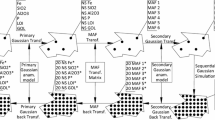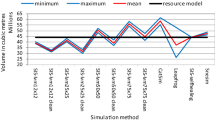Abstract
The most common approach used in the mining industry for mineral resources modeling is to estimate the grades using ordinary kriging and report the recoverable resources based on this deterministic estimated model. Mineral resources calculated with kriging are a smooth representation of the actual distribution of grades and do not provide an assessment of uncertainty. Unlike kriging, simulation reproduces the variability of the grades in the mineral deposit and provides an assessment of uncertainty. Reporting mineral resources directly on high-resolution simulation results would assume perfect knowledge of the grade at the time of mining and selectivity at the scale of the data. There will always be uncertainty left at the time of mining, so assuming perfect knowledge of the grade in the future is incorrect. There are two concerns when geostatistical simulation is used for resources modeling: the information and the mining selectivity effects. A new framework for resource estimation is proposed with two separate modules to address those concerns. The information effect is accounted for by anticipating the additional production data that will be available at the time mining to guide the destination for the mined material. The mining selectivity effect is addressed by mimicking the grade control procedure to get mineable dig limits at a chosen selectivity, represented by a minimum mineable unit size. In addition to a prediction of recoverable resources that will be closer to the material mined in the future, the framework proposed provides an assessment of local and global uncertainty for risk management.












Similar content being viewed by others
References
Benndorf J, Dimitrakopoulos R (2007) New efficient methods for conditional simulation of large orebodies. Orebody Modelling and Strategic Mine Planning Spectrum Series 14:103–110
Cuba MA, Boisvert J, Deutsch CV (2012) Simulated learning model for mineable reserves evaluation Centre for Computational Geostatistics Annual Report:14
Deraisme J, Roth C (2000) The information effect and estimating recoverable reserves. Geovariances. https://www.geovariances.com/en/ressources/information-effect-estimating-recoverable-reserves/. Accessed 15 May 2018
Deutsch CV, Journel AG (1998) GSLIB: geostatistical software library and user’s guide, 2nd edn. Oxford University Press, New York
Deutsch CV (2015) All realizations all the time. Centre for Computational Geostatistics Annual Report 17
Deutsch CV (2017) IGC-DL: Intelligent grade control - dig limits (Version 0.1). Centre for Computational Geostatistics Annual Report 19
Emery X (2009) Change-of-support models and computer programs for direct block-support simulation. Comput Geosci 35(10):2047–2056. https://doi.org/10.1016/j.cageo.2008.12.010
Emery X, Ortiz JM (2011) Two approaches to direct block-support conditional co-simulation. Comput Geosci 37(8):1015–1025. https://doi.org/10.1016/j.cageo.2010.07.012
Geovariances (2018) What’s new in ISATIS 2018? Geovariances. https://www.geovariances.com/wp-content/uploads/2018/04/isatis-v2018-new-features.pdf. Accessed 3 May 2018
Goovaerts P (1997) Geostatistics for natural resources evaluation. Oxford University Press, New York
Isaaks EH, Srivastava RM (1989) Applied geostatistics. Oxford University Press, New York
Journel AG, Huijbregts C (1978) Mining geostatistics. Academic Press, London
Journel AG, Kyriakidis PC (2004) Evaluation of mineral reserves: a simulation approach. Oxford University Press, New York
Leuangthong O, Neufeld C, Deustch CV (2003) Optimal selection of selective mining unit (SMU) size. Centre for Computational Geostatistics Annual Report 05
Machuca-Mory DF, Babak O, Deutsch CV (2008) Flexible change of support model suitable for a wide range of mineralization styles. Min Eng 60(2):63–72
Neufeld C, Deutsch CV (2005) Calculating recoverable reserves with uniform conditioning. Centre for Computational Geostatistics Annual Report 07
Neufeld C, Leuangthong O, Deustch CV (2007) A simulation approach to account for the information effect. Centre for Computational Geostatistics Annual Report 09
Nowak M, Leuangthong O (2017) Conditional bias in kriging: let’s keep it. Quant Geol Geostat 19:303–318. https://doi.org/10.1007/978-3-319-46819-8_20
Rossi ME, Deutsch CV (2014) Mineral resource estimation. Springer, Dordrecht
Sinclair AJ, Blackwell GH (2002) Applied mineral inventory estimation. Cambridge University Press, Cambridge
Vasylchuk YV (2016) Integrated system for improved grade control in open pit mines. University of Alberta, Dissertation
Vasylchuk YV, Deutsch CV (2017) Intelligent grade control – overview. Centre for Computational Geostatistics Annual Report 19
Author information
Authors and Affiliations
Corresponding author
Ethics declarations
Conflict of Interest
The authors declare that they have no conflict of interest.
Additional information
Publisher’s Note
Springer Nature remains neutral with regard to jurisdictional claims in published maps and institutional affiliations.
Rights and permissions
About this article
Cite this article
Chiquini, A., Deutsch, C.V. Mineral Resources Evaluation with Mining Selectivity and Information Effect. Mining, Metallurgy & Exploration 37, 965–979 (2020). https://doi.org/10.1007/s42461-020-00229-2
Received:
Accepted:
Published:
Issue Date:
DOI: https://doi.org/10.1007/s42461-020-00229-2




